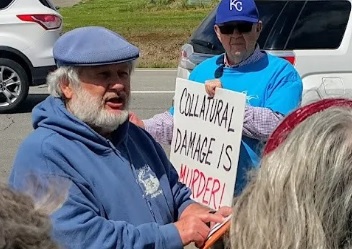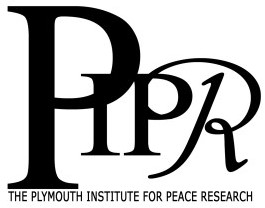“An Unspeakable Crime”
By Brian Terrell
31 May, 2022

On the occasion of the Prohibit Nukes, Promote HOPE—Memorial Day walk, rally at the Kansas City National Security Campus on May 30, 2022
Four months ago, two days before the civilized world celebrated one year since the Treaty on the Prohibition of Nuclear Weapons came into force on January 22, officials here at the Kansas City National Security Campus hosted a virtual celebration of a different milestone with partners from across the National Nuclear Security Administration and U.S. Air Force. “With great pride and excitement,” they recognized the completion of the B61-12 bomb’s Life Extension Program’s first production unit. This plant is responsible for producing 39 major non-nuclear component assemblies of the B61-12.
The trillion-dollar program of extending the lives of nuclear weapons is at odds with the Nuclear Non-Proliferation Treaty, ratified into law by the United States, flouting Article VI of the treaty, which requires “all Parties undertake to pursue good-faith negotiations on effective measures relating to cessation of the nuclear arms race, to nuclear disarmament, and to general and complete disarmament.” In the nine years since the B61-12 Life Extension Program was put into action, the life expectancy of humans in this country has plummeted. Undaunted, the NNSA boasts that it has extended the life expectancy of the B61-12 by at least 20 years!
This new bomb will replace the old B61, the primary thermonuclear gravity bomb in the U.S. arsenal, also deployed with NATO allies in Europe as part of a “Nuclear Weapons Sharing Program”. One improvement is that these new bombs have steerable tail fins that make them much more precise and deployable. Their explosive force can also be dialed up or down from 1 to 50 kilotons, that is, more than three times the power of the bomb that destroyed Hiroshima in 1945.
“More precise and deployable” is another way of saying more likely to be used, and with these new weapons on hand, U.S. war planners are thinking up ways to use them. A June, 2019, report by the U.S. Joint Chiefs of Staff, “Nuclear Operations,” suggests that “using nuclear weapons could create conditions for decisive results (and) affect how commanders will prevail in conflict.”
I was in Europe last fall during NATO’s “Steadfast Noon” exercises, the annual event where the militaries from 14 NATO countries rehearse an invasion of Russia. These rehearsals explain how an expanding NATO armed with more precise and flexible nuclear weapons like the ones made right here in Kansas City might tip a precarious balance. Since the invasion of Ukraine, Russian commanders have likewise speculated on how their own more precise and flexible nuclear weapons could help them prevail.
“The United States would only consider the use of nuclear weapons in extreme circumstances to defend the vital interests of the United States or its allies and partners,” says the Pentagon’s 2022 Nuclear Posture Review. Russia, more modestly for its part, has abandoned its own no first use policy and “reserves the right to use nuclear weapons… when the very existence of the state is in jeopardy.”
Nation states, their vital interests and their very existence are temporary. These threats to destroy the planet in their defense are insane.
It was believed that a doctrine of “mutually assured destruction,” that the horrific devastation wrought by a nuclear exchange would leave no winner, is what helped prevent a world war over the last decades. The growing delusion among war planners that a nuclear war can be won places the world in unprecedented peril. In this time of climate catastrophe, famine and pandemic, the waste of resources to build nuclear weapons is an unspeakable crime.
In 1949, early in the cold war with Russia, the monk and poet Thomas Merton wrote, “When I pray for peace, I pray God to pacify not only the Russians and the Chinese but above all my own nation and myself. When I pray for peace, I pray to be protected not only from the Reds but also from the folly and blindness of my own country. When I pray for peace, I pray not only that the enemies of my country may cease to want war, but above all that my own country will cease to do the things that make war inevitable. In other words, when I pray for peace, I am not just praying that the Russians will give up without a struggle and let us have our own way. I am praying that both we and the Russians may somehow be restored to sanity and learn how to work out our problems, as best we can, together, instead of preparing for global suicide.”
Brian Terrell is a Catholic Worker based in Maloy, Iowa, and is outreach coordinator for the Nevada Desert Experience

